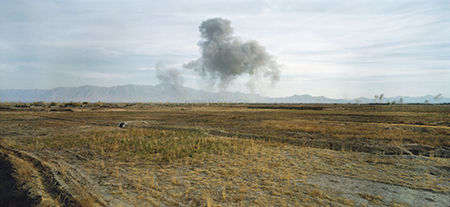Conflict, Time, Photography
Tate Modern, London, UK
Tate Modern, London, UK

Time was both organizing principle and conceptual conceit in Tate Modern’s exhibition of images of conflict, curated by Simon Baker, with Shoair Mavlian and David Mellor. The show, which will tour to venues in Essen and Dresden, included work by more than 40 artists and photographers, recording events, and their reverberations, from around the world. Material spans the medium’s history, from Roger Fenton’s Valley of the Shadow of Death (1855), an eerily empty ravine littered with cannon balls in the midst of the Crimean War, to Stephen Shore’s recent project ‘Ukraine’ (2012–13), a tender exploration of the lives of Holocaust survivors, shown through everyday objects, interiors and portraits, and a selection from Diana Matar’s long-term project ‘Evidence’ (2012–13), views of desolate urban landscapes that were sites of violence in Libya under Gaddafi. These examples, however, were neither the first nor the last photographs on view: rather than arranging works chronologically – or geographically or monographically – they were ordered instead according to the time lapsed between event and image. Beginning moments afterwards and retreating incrementally from the immediacy of conflict, months, years, decades and, ultimately, a century elapses between the event and the making of the picture.
It’s a neat device, one that offers a different perspective – and different challenges – from many of the exhibitions of images of war and disaster that seem to abound these days. These feel like apt subjects for the centenary years of World War I and, more urgently, amidst the images of revolution and terror we all absorb today – in photographs, on television and broadcast on YouTube.
In ‘Conflict, Time, Photography’, the criterion of temporal distance pointedly made present-day hostilities more or less off limits. The conceit also resisted concentrated examinations of place or period, which had the disorienting effect of downplaying the politics of the pictures. The exception, and perhaps the most striking grouping in the exhibition, occurred in the first rooms, where images made immediately after violent events – all of which centre on US actions (in Hiroshima, Vietnam, Afghanistan and Iraq) – showed a range of approaches and distances. In these spaces, visitors moved from Luc Delahaye’s panoramic view of a distant cloud of smoke hovering above fields and mountains in US Bombing on Taliban Positions (2001), to the intense stare of Don McCullin’s Shell-shocked US Marine (1968), to abstract streaks of black, orange, blue and white in an image from Adam Broomberg & Oliver Chanarin’s The Day Nobody Died (2008). For the latter, the artists, embedded with the British Army in Helmand Province at the time, exposed sections of a large roll of photographic paper to the sun to mark moments of violence – a form of resistance to traditional photojournalistic representation. With the exception of McCullin’s, these works do not use photojournalistic strategies, and even his soldier was here enlarged to relate to the scale of the more contemporary works. Yet there is a currency that unites them even as they also explore the range of possible photographic responses to such unimaginable events – from a human face to the remove of landscape to oblique trace.
The temporal relation among projects was murkier in the heart of the show, where the most powerful works asserted an independent presence and suggested different relations to time. Susan Meiselas’s ‘Reframing History: Nicaragua 25th Anniversary Project’ (2004), for example, deals directly with the way that images, over time, can operate as cultural symbols. Meiselas went back to Nicaragua a quarter of a century after photographing the insurrection in 1978, installing billboard-sized images from her own archive in the places they were first taken and then filming the responses and reactions of people as they came upon them. Time in this work is collapsed, with past moments inserted into the present of decades later.
The curatorial frame could be hard to get a grip on, in part because these kinds of intervals are not always so easy to measure. Wars are messy, after all – they don’t end cleanly or clearly, and their aftermaths beget new struggles for power and freedom. The psychology of ongoingness was itself pervasive in the show, in projects that return, compulsively, to record traces and scars – such as Sophie Ristlehuber’s Fait (1992) and Shomei Tomatsu’s 11:02 Nagasaki (1966), which deal with the irrevocable effects of the first Gulf War and the second atomic bomb dropped on Japan, respectively.
Some projects, however, seemed lost or out of place, notably Broomberg & Chanarin’s other major work on view, People in Trouble Laughing Pushed to the Ground (2011), an intervention using images from the Belfast Exposed Archive, home to thousands of photographic contact sheets documenting the Troubles in Northern Ireland. Shown at Tate in a spectacular floor-to-ceiling grid, the installation’s abstract volume superseded individual images, many of which were regrettably hung too high to be legible. Toward the end of the show, the Archive of Modern Conflict’s curiosity-shop room, decorated with period wallpaper, black and white photographs and stagy props, was jarring in its departure from the show’s tone and curatorial trajectory.
This wasn’t, ultimately, a show about specific conflicts, or even conflict in general. It was about photography’s relation to these events: about distance, trace and memory, and photography as a mode of remembering, reflecting and abstracting. There’s a danger in this – a futility in dwelling, an impotence in retrospection and a tipping point for abstraction, which can so easily turn the horrific into the spectacular or beautiful. But these are also all tendencies that photography has to grapple with, and this exhibition was all the more interesting for throwing them into relief. Could there be a ‘successful’ show of images of war? Would we want one?
























